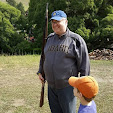The gaming group got together today for a 25mm Napoleonics battle. We played through the 1806 battle of Maida twice, using Jon's Front Rank British army and my Old Glory French army. We used Jon's own rules, which are great for very small scale battles. The figure scale is 1:50, the ground scale is 1"=25 yards, and the time scale is 1 turn=15 minutes.
Jon umpired and took pictures. Austin and Don commanded the British, while Scott R. and I commanded the French. Click on any picture for a larger image.

Game 1 Initial Setup
The setup was the same for both games. The French had three brigades with five light and four line battalions, 1 regiment of light cavalry, and two sections of artillery. The two British brigades occupied the high ground with six battalions of infantry and four sections of artillery.

Game 1 The Whole Table
The French had a tough nut to crack. An advance right up the center would have to cover open ground devoid of any cover. Yet both British flanks were covered by terrain that would slow the French down and make it difficult to coordinate French attacks.

Game 1 Advance on the British Right / French Left
I commanded the largest French brigade and set out to pin the British right while Scott R. maneuvered against the British left. My legere battalions took a pounding from the British guns, but managed to keep Don's men occupied.

Game 1 French Attack the British Left
While I demonstrated, Scott R. sent a mixed brigade of infantry and cavalry on a long march against the British left. This left just three small French battalions facing the British line. Austin, in command of the British left, decided to attack! The British came down from their strong position, but the French infantry won the combat that ensued. As Austin's brigade fell back, Scott R.'s flanking force fell on the undefended guns. Here you can see French light cavalry taking the British leftmost battery.

Game 1 Heavy Skirmishing on the British Left
While Scott R. took Austin's position, I was heavily engaged with Don's British brigade. Here you can see the Corsican Rangers (95th Rifles) chewing up one of my legere battalions. Both regiments have skirmish screens deployed to their side. The preponderance of French skirmishers allowed us to disrupt many British battalions before the main lines ever engaged.

Game 1 Situation at the End
With their left flank dissolving and their right under heavy pressure, the British commanders decided to call the game. Here you can see the overall situation. Don's British brigade, on the French left, was still largely intact. The 95th rifles were engaged in a firefight with a French battalion, one other battalion had been forced back but was rallying, and the third battalion still held its position on the ridge line. Austin's brigade, on the French right, was in rougher shape. The British Guards battalion, seen here in the open plain, had pushed back two French battalions, but a third French battalion was squarely on their flank while the two defeated battalions rallied and prepared to renew the advance. Austin's second battalion (with the Portuguese colors) had rallied, but had lost four of its six stands. Austin's third battalion had routed off the table. Scott's flanking force was in position to roll up the British line.
We had a pizza break (with really excellent pizza, Pizza Rita's; look them up if you're ever in Spokane) and returned to fight it out again.

Game 2 Initial French Move
We kept the same sides for the second game, but Austin and Don switched brigades. Scott R. and I decided to try the other flank. Here is the view from the British lines. You can see my legere off to the right, preparing to move through the thicket and engage the British right.

Game 2 French Flank Attack Moves into Position
Under a heavy screen of skirmishers, I moved against the British left. Scott R.'s two brigades are to the right.

Game 2 Don Attacks!
With the brunt of the French attack again falling on Austin, Don threw one battalion forward to engage Scott R.'s rightmost brigade. Don wanted to press the attack home, but without orders to engage, his men had to satisfy themselves with long range skirmishing. Scott R.'s artillery was able to cause some damage to the British advanced battalion.

Game 2 The French Carry the Hill
Scott R. charged a British battalion with infantry, which was thrown back, then cavalry, which destroyed the British battalion. Meanwhile I issued my brigade engage orders and carried the hill. The French legere pushed back Austin's two other battalions and inflicted heavy losses.

Game 2 Austin Has a Rough Day
We had focused our main attacks on Austin's portion of the line both times. Here a peeved Austin reflects on the folly of containing French revolutionary fervor.

Game 2 Final Situation on the French Left
Here's a closer look at the French legere as they face Austin's last remaining battalion.

Game 2 Final Situation on the French Right
Scott R. had a strong skirmish screen and artillery on the right, and he had captured the ridge in the center. Don was moving to refuse his flank, but the French had a good position, and most of Scott R.'s troops had not suffered serious casualties.

Game 2 Don Surrenders
With the British line collapsing, Don decided to raise the white flag (or napkin). All five of us enjoyed the day. Jon's rules were easy to learn, and they gave a good result. The British were outnumbered and without cavalry, and the heavy legere skirmish screens gave the French a big advantage. Maybe the British can win this one with some better die rolls, but the day went to the French.





































































